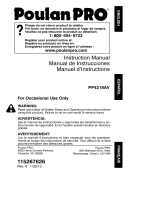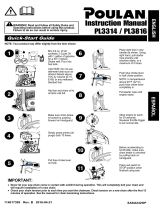
YOUR WARRANTY RIGHTS AN D OBLIGA-
TIONS: The U.S. Environmental Protection
Agency, California Air Resources Board, Envi-
ronment Canada and ELECTROLUX HOME
PRODUCTS, INC., are pleased to explain the
emissions control system warranty on your
year 2002-2004 small off-road engine. InCali-
fornia, all small off-toed engines must be de-
signed, built, and equipped to meet the State's
stdogent anti-smog standards. ELECTRO-
LUX HOME PRODUCTS, INC., must warrant
the emission controt system on your small off-
road engine for the periods of time listed below
provided there has been no abuse, neglect, or
improper maintenance of your small off-road
engine. Your emission control system includes
ports such as the carburetor and the ignition
system. Where a warrantable condition exists,
ELECTROLUX HOME PRODUCTS, INC.,
will repair your smati off-road engine engine at
no cost to you. Expenses covered under war-
ranty include diagnosis, ports and labor.
MANUFACTURER'S WARRANTY COVER-
AGE: Ifany ecnissions related par[ on your en-
gine (as listed under Emissions Control War-
ranty Pads List) is defective or a defect in the
materials or workmanship of the engine
causes the failure of such an emission related
por[, the pad will be repaired or replaced by
ELECTROLUX HOME PRODUCTS, INC.
OWNER'S WARRANTY RESPONSIBILI-
TIES: As the small off-road engine engine
owner, you are responsible for the perfor-
mance of the required maintenance listed in
your instruction manual. ELECTROLUX
HOME PRODUCTS, INC., recommends that
you retain all receipts covering maintenance on
your small off-road eogine, but ELECTROLUX
HOME PRODUCTS, iNC., cannot deny war-
ranty solely for the lack of receipts or for your
failure to ensure the performance of all sched-
uled maintenance. As the small off-road en-
gine engine owner, you should be aware that
ELECTROLUX HOME PRODUCTS, INC.,
may deny you warracty coverage if your small
off-road engine engine or a part of it has failed
due to abuse, neglect, improper maintenance,
unapproved modifications, or the use of parts
not made or approved by the original equip-
ment manufacturer. You are responsible for
presenting your small off-road engine to an
ELECTROLUX HOME PRODUCTS, INC.,
authorized repair center as soon as a problem
exists. Warranty repairs should be completed
in a reasonable amount of time, not to exceed
30 days. If you have any questions regarding
your warranty rights and responsibitities, you
should contact your nearest authorized service
center or call ELECTROLUX HOME PROD-
UCTS, INC., at 1-800-554-6723. WARRAN-
TY COMMENCEMENT DATE: The warranty
period begins on the date the small off-road
engine is purchased. LENGTH OF COVER-
AGE: This warranty shati be for a period of two
years from the initial date of purchase. WHAT
IS COVERED: REPAIR OR REPLACE-
MENT OF PARTS, Repair or replacement of
any warranted part will be performed at no
charge to the owner at an approved ELEC-
TROLUX HOME PRODUCTS, INC., servic-
ing center. Ifyou have any questions regarding
your warranty rights and responsil:41itJes, you
sbeu]d contact your nearest authorized service
center or ca]i ELECTROLUX HOME PROD-
UCTS, INC., at 1-800-554-6723. WARRAN-
TY PERIOD: Any warracted part which is not
scheduled for replacement as required mainte-
nance, or which is scheduled only for regular
inspection to the effect of "repair or replace as
necessary" shall bewarranted for 2 years. Any
warranted part which is scheduled for replace-
ment as required maintenance shaft be war-
ranted for the period of time up to the first
scheduled replacement point for that part.
DIAGNOSIS: The owner shall not be charged
for diagnostic labor which leeds to the deter-
mination that a warracted part is defective ifthe
diagnostic work is performed at an approved
ELECTROLUX HOME PRODUCTS, INC.,
servicing cecter. CONSEQUENTIAL DAM-
AGES: ELECTROLUX HOME PRODUCTS,
INC., may be liable for damages to other en-
gine components caused by the failure of a
warranted part still under warranty. WHAT IS
NOT COVERED: All failures caused by abuse,
neglect, or improper maictenance are not cov-
ered. ADD-ON OR MODIFIED PARTS: The
use of add-on or modified ports can be
grounds for disallowing a warranty claim.
ELECTROLUX HOME PRODUCTS, INC., is
not liable to cover failures of warranted parts
caused by the use of add-on or modified pods.
HOW TO FILE A CLAIM: If you have any
questions regarding your warranty rights and
responsibilities, you sbeuld contact your near-
est authorized service center or call ELEC-
TROLUX HOME PRODUCTS, INC., at
1-800-554-6723. WHERE TO GET WAR-
RANTY SERVICE: Warrar_ty services or re-
pairs shall be provided at aft BLECTROLUX
HOME PRODUCTS, INC., service centers.
Call: 1-800-554-6723 MAINTENANCE, RE-
PLACEMENT AND REPAIR OF EMISSION
RELATED PARTS: Any ELECTROLUX
HOME PRODUCTS, INC., approved replace-
ment par[ used inthe performance of any war-
ranty maintenance or repair on emission re-
lated parts will be provided without charge to
the owner if the par[ is under warranty. EMIS-
SION CONTROL WARRANTY PARTS LIST:
Carburetor, Ignition System: Spark Plug (cov-
ered up to maintenance schedule), Ignition
Module, Muffler including catalyst. MAINTE-
NANCE STATEMENT: The owner is responsi-
ble for the performance of all required mainte-
nance as defined in the instruction manual.
17






















